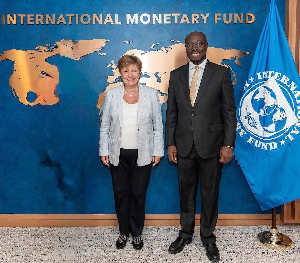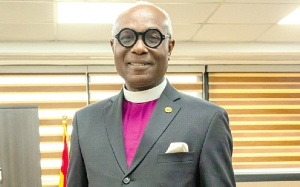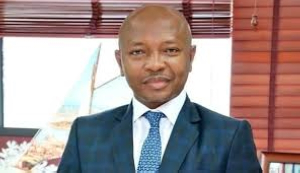Minister of Railway Development, Mr Joe Ghartey has justified moving the rail head of the 97.3 kilometres Single Standard Gauge Railway Line being constructed from Tema, from Akosombo to Mpakadan.
Mr Joe Ghartey while enumerating factors that necessitated the relocation said the potential to create a business hub among others informed the decision of the ministry to locate the rail head at Mpakadan.
Speaking to the media during a monitoring visit to the site at Mpakadan last Thursday, Mr Ghartey explained that the relocation became necessary following assessment of the effects of construction works on the Akosombo dam.
The Railways Development minister said blasting and other heavy activities at the Akosombo port which is 60 meters close to the Akosombo dam could pose a great risk to the safety of the dam hence the need to move the port to Mpakadan.
There was also the need, said the minister to site the project “at a place where businesses can come around it.” He was convinced that siting of the rail head at Mpakadan aside its business opportunities would also provide additional investment opportunities to the area as investors were ready to build the port and a real estate respectively, a development he argued cannot be undertaken at the earlier proposed site.
The risk of threats of terrorism on the dam as a result of the huge number of passengers who would flock Akosombo via rail transportation, Mr. Ghartey explained, also informed the decision for the relocation of the port from Akosombo.
The Railways Development minister who said the project is expected to connect the south through the Volta region to the northern part of the country therefore wondered the convenience in “branching” to Akosombo en route to the north.
“We are going to the north through Ho, Hohoe, all the way to Yendi, Shane to Tamale, so why do you branch and go and hide yourself in Akosombo?” he quizzed. “We have started a journey to the north and the train is passing through the Volta region. This is the first time in the history of our country that the State is creating a train line that will pass through the Volta region.”
“So far, so good,” said the minister when asked his assessment of work done so far. He however added that though they encountered challenges with land, the problem was being addressed, warning however that encroachers will not be compensated.

The minister as part of his tour also paid a visit to the Tropo farms where he allayed fears of the management of the facility of the possibility of the rail affecting the operations of the farms. He assured them that though the course of the rail line will be close to the farm, the contractors would ensure that it did not affect the operations of the tilapia farm.
The minister was accompanied by Mr Udai Veer Singh, the General Manager of Afcons Infrastructure Limited, the contractor on the project, District Chief Executive for Asuogyaman, Samuel Kwame Agyekum, the District Coordinating Director and other officials from the Asuogyaman district assembly.
Work on the 99-kilometre Tema-Mpakadan railway line is expected to be completed in June 2020, the Minister of Railway Development, Mr Joe Ghartey, said.
The project, which starts from Tema through Afienya and parts of the Volta Region (North Tongu) and terminates at Mpakadan, a few kilometres away from Akosombo, will cost the country about $230 million.
Meanwhile, several structures, farmlands and residential buildings along the stretch, will be demolished to pave the way for the construction of the rail line.
Compensation
The railways minister said many people had encroached on parts of the Tema railway line and warned that the GRDA would not pay compensation to encroachers.
He said the ministry had so far paid compensation for crops along the new stretch and was in the process of evaluating landed property, as well as the land for the railway itself, for the second and third phases of the compensation process.
"We have three phases — the crop compensation, land compensation and structures compensation," he explained, pointing out that the Lands Commission would soon complete the land and structures evaluation.
General News of Sunday, 1 September 2019
Source: Michael Oberteye













